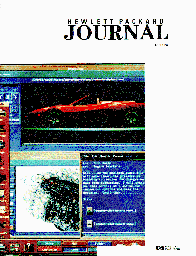|

The 1990s may be remembered as the decade when multimedia capability became
commonplace in computer technology, communications, and entertainment. The
exact meaning of multimedia depends on who's using the word. On HP engineering
workstations (HP 9000 Series 700 and 800 computers), one meaning of multimedia
is HP MPower, a collection of multimedia hardware and software tools and applications
that allow users to create, manipulate, and share textual information and nontextual
information such as audio, image, graphics, and video data over a network.
As described in the article on page 10, on an HP MPower-equipped workstation
the following services are available to the user: faxing, online documentation,
scanning, image viewing, audio recording and playback, video in a window, window
capture, whiteboard collaboration, real-time application sharing, and color
graphics and PostScriptE printing. The development of HP MPower has been an
evolutionary process, with new capabilities being developed as user needs changed
and new technologies became available, and the product continues to evolve.
The article on page 6 tells the story of this evolution and goes on to describe
two very recently released HP MPower capabilities: digital video, or full-motion
video with synchronized audio, and telephone functionality with a new HP MPower
telephony component, HP TeleShare. These last two media types were added to
HP MPower too late for articles on them to be prepared in time for this issue.
We hope to include articles on their design in a future issue.
HP MPower, its various components, and its client/server architecture are introduced
in the article on page 10. HP MPower's graphical user interface is the HP Visual
User Environment, HP VUE. It's the subject of the article on page 20. The application
sharing component of HP MPower is HP SharedX (page 23), a communication tool
that extends the industry-standard X Window System so that two or more users
at different workstations can share and interact with the same X-protocol-based
applications almost as if they were at the same workstation. Existing X applications
don't have to be changed to be shared with HP SharedX. Implementing this new
application sharing technology in a heterogeneous computing environment, the
designers discovered, poses many difficult design challenges, some of which
don't have perfect solutions. A component of HP SharedX called Whiteboard (page
28) allows users to share a snapshot of a portion of a display and to annotate
that snapshot.
Image files contain computer graphics and digital records of physical objects
such as photographs, pages from books, and faxes. The HP Image Library (see
page 37) contains image manipulation tools, compression and decompression functions,
picture quality adjustment functions, and support for industry standards. Its
functionality is used by several HP MPower components. For environments in
which users have a multitude of printers to choose from, HP SharedPrint (page
44) provides a simple graphical interface that enables users to select a target
printer and a set of options without many of the typical problems. The HP MPower
fax utility (page 53) provides automatic dialing, transmission, and delivery
of facsimile documents from a workstation.
HP MPower provides the hardware and software for recording and playing audio
files over a network, incorporating audio in email, adding audio annotations
to system files, and recording and playback using external devices such as
tape recorders, CD players, and VCRs. HP MPower's audio functionality, application
development tools, and hardware and software audio architecture are described
in the article on page 62. Video technology in HP MPower is provided by a hardware/software
component called HP VideoLive (page 68). It provides full-motion video in a
movable, scalable window and works with existing HP graphics subsystems without
degrading system or graphics performance.
HP MPower also provides a multimedia email, or electronic mail, facility (see
page 71). The well-established processes of creating, sending, receiving, printing,
and replying to email messages are maintained and applied to messages containing
multimedia objects such as image and audio files.
Nearly 2000 online help topics are shipped with HP MPower. The HP online help
system used by HP MPower and other HP applications is described in the article
on page 79. On page 90, one of the designers of the HP help system advises application developers on the issues they may encounter in providing online help for their
applications.
R.P. Dolan
Editor
|
|